Tribute to a Planter: Tan Sri Dato’ Dr Lee Shin Cheng
By gofb-adm on Wednesday, June 26th, 2019 in Issue 2 - 2019, Memoriam No Comments

By gofb-adm on Wednesday, June 26th, 2019 in Issue 2 - 2019, Memoriam No Comments
Today, my mind turns to a subject I did not think I would have to write about, and it is the passing of Tan Sri Dato' Dr Lee Shin Cheng on the evening of June 1, 2019, two days short of his 80th birthday.
Read more »By gofb-adm on Wednesday, June 26th, 2019 in Issue 2 - 2019, Memoriam No Comments
Datuk Leslie Davidson, a pioneer of Malaysia's oil palm industry, passed away in the UK on April 14, 2019. He was 88, Plantation consultant Mahbob Abdullah pays tribute to a dedicated planter whose ideas helped revolutionise and expand the sector.
Read more »By gofb-adm on Monday, June 24th, 2019 in Issue 2 - 2019, Special Report No Comments
By gofb-adm on Monday, June 24th, 2019 in Issue 2 - 2019, Publication No Comments
From 1965 to 1967, in addition to bringing to completion our programmes for planting, roads and buildings, we were also very preoccupied with the erection of our factory. At that time, the only company which could build a standard turn-key palm oil mill on contract, was Messrs Stork of Amsterdam.
Read more »By gofb-adm on Monday, June 24th, 2019 in Planter's Diary, Issue 2 - 2019 No Comments
Borge Bek-Nielsen’s first boss, Axel Lindquist, was accustomed to fly a British built two-seater Auster J2 high wing monoplane from United Plantations’ Ulu Bernam Estate. He would fly to meetings at the company’s headquarters at Jendarata and for weekends to Penang. Each venue was less than half an hour’s flying time from Ulu Bernam. Ipoh, the capital of Perak, was an hour away, and the bright lights of Kuala Lumpur might be up to two hours away during the rainy season.
When Bek had completed his palm oil mill training at Ulu Bernam and after he had sat for the Steam Certificate, Axel taught him how to fly. Five years later, he bought his first aircraft, a fully aerobatic Bellanca Citabria. It was the one-time property of a member of the Penang Aero Club – a serving US Colonel in the Vietnam War who, on being offered promotion to command a US Pacific Island airbase, offered his hobby-horse for sale.
Within five years of Bek starting work at Ulu Bernam, a plantation in Kedah signalled its need for a palm oil mill. By any form of late 1950s reckoning, Gebr. Stork’s oil palm mill monopoly from Amsterdam was a questionable match for ‘Made at Ulu Bernam’ know-how; even Stork’s very mill buildings were supplied from Holland. Then Malaya had no domestic commercial alternatives to Gebr. Storks’ time-proven, reliable palm oil mills.
Bek hired a part-time draughtsman to work for him on mill design at Ulu Bernam. His motto, ‘Made at Ulu Bernam’, moved up a notch to ‘Designed and made at Ulu Bernam’. He found a civil engineering contractor, Mr Lee Fook Sum of Capital Engineering, Klang. He was willing to prefabricate all-steel buildings in his yard, as well as carry out the on-site civil engineering work required for building and machinery foundations. Together, they found workmen who were trained in the shipping industry, and railway and workshop machinery installation.
Bek undertook to design the larger items of palm oil mill mechanical inventory items, including the water purification system, fresh fruit bunch ramp, horizontal sterilisers, elevators, conveyors, pressing station, palm oil separation, water and oil tanks and the nut plant. He continued to make use of Stork fruit digesters, Stork automatic oil recovery presses, Stork palm oil sludge centrifuges (some of which are still in use 60 years later!) and Stork nutcrackers.
The contracts were duly signed and Bek’s first mill construction was set in motion. He made it a point to pay an afternoon visit to the Kedah plantation site once or twice a week to monitor the physical progress. Every now and again, a mini-crisis would loom; fittings supplied didn’t match their foundations or a support girder went missing somewhere along the supply line.
Shocking end
Came the day – actually one fine afternoon – when Bek requested a test run at the new mill. He was watching some adjustments being carried out when the patter of rain reminded him of his schedule. He set off from the Kedah airfield within half an hour, only to find that a thunderstorm had developed along his route back to Ulu Bernam.
His only course was to fly southwards along the Kedah coast in the fading evening light. The storm passed while he was – by his aircraft clock – only a few minutes out from Ulu Bernam, but he was obliged to locate his airstrip from an unfamiliar direction.
It was almost dark. He flew across a new rubber replanting site on the coastal flats – across which a bicycle lamp was steadily making its way. A straight road appeared behind the cyclist. Bek made a U-turn in the Citabria and landed on the road behind the worker.
He jumped out to ask one surprised Indian man of his actual whereabouts. The man explained. In a flash he remembered – a rubber replanting site less than 10 miles cross-country from Ulu Bernam. Good. Now all he needed to do was buzz the Ulu Bernam mill and wait for the Land Rover to light up the other end of his airfield with two sets of runway indicators; it had all been done before.
But first there was the small matter of departure. He requested the awestruck Indian man to cycle to the other end of the field and stand with his kerosene lamp in the centre of the road. Done. Good.
He locked the parking brake and turned over the Lycoming engine. In a few moments, the hot machine was running smoothly. Sitting on his briefcase, he could just make out the wavering kerosene lamp over the top of the engine cowling; he locked his door panel, turned on the landing light, opened the throttle fully and released the brake. The Citabria rolled smoothly down the road and Bek eased the stick forward to raise the tail wheel. The lamp down the road wavered as his speed was building up.
Without warning, his left-hand undercarriage fell away; the propeller hit the road with a ‘whop’ and a terrible snap. Bek was thrown against the cabin roof and the Citabria slid with a hiss into the roadside drain. He somehow found his briefcase and managed to scramble clear.
The Indian man reappeared out of the gloom. “Tuan,” he said, “you rolled off to one side of the centerfield bridge.”
Bek said: “What to do. Too late now. Fifty ringgit to cycle me back opposite to Ulu Bernam, please?”
My God, half a month’s wages to cycle a white man back home. Just wait till he could tell his friends on his return! Bek set off on the back of the old bicycle, the first time he’d done that since he was at school. The journey took over an hour.
The Bernam River ferry attendant, dozing in his cabin on the side of the Sungei Samak, jumped up as surprised as if he had seen a ghost. He burst into roars of laughter at the Indian man’s explanation of the aircraft landing in the gloaming on the rubber replanting road; then later ditching into the roadside drain. Bek accepted a hastily-made hot drink from the ferryman’s wife before setting off on the five-minute journey across the river.
Muthu, Bek’s cook, cried when he heard about the lucky escape and wanted to call a Malay pawang to interpret the omens. Some Ulu Bernam mill staff rushed over to the house. Bek normally never drank by himself but, when he finally sank into his accustomed chair, he was hit by the shakes. It took him fully 10 minutes to settle down, after which he took stock of what had happened.
He told himself: “Well, better count that as ‘a couple of my nine lives’ used up. Still a handful to go!”
The next morning Ralph Grut, General Manager at Jendarata confirmed it: “Bek, next time please try your luck only once. Twice is pushing it!”
Moray K Graham
Retired Planter
By gofb-adm on Monday, June 24th, 2019 in Issue 2 - 2019, Nutrition No Comments
The well-known tagline:
“Saturated fats cause heart diseases”
“Palm oil is a saturated fat”.
These smear campaigns are aimed at demonising tropical oils and specifically palm oil. The negative labelling had badly affected and stigmatised palm oil. This is a ploy used by the competitor to hide the harmful health problems caused by trans fats or “artificial saturated fats” they had produced, and through deceitful marketing, portrayed it as a natural saturated fat issue (https://experiencelife.com/article/big-fat-controversy/). Based on a report published in the American Journal of Preventive Medicine, Time magazine mentioned that Denmark had banned trans fats between 2003 and 2012, resulting in deaths caused by cardiovascular disease to slide from 359.9 to 210.9 per 100000 people (http://time.com/4025570/denmark-trans-fat-ban/). US FDA (Food and Drug Administration) ban only starts in 2018 (https://www.nytimes.com/2015/06/17/health/fda-gives-food-industry-three-years-eliminate-trans-fats.html).
Ancel Keys first hypothesise that dietary saturated fat causes cardiovascular heart disease and should be avoided (https://en.wikipedia.org/wiki/Ancel_Keys). In 1957, he and his colleagues embarked on an intensive survey comprising 12 000 men aged from 40 to 59 from 18 regions of seven countries and is known as the “Seven Countries Study”. The report published in 1970 had a decisive impact on cardiovascular disease (CVD) prevention, as it described one of the first studies to clearly show that dietary saturated fat leads to CVD, and that the relationship is mediated by serum cholesterol (https://www.bcmj.org/articles/ancel-keys-and-lipid-hypothesis-early-breakthroughs-current-management-dyslipidemia). A physiologist by training, Ancel Keys also ended up in the nutrition committee of the American Heart Association (AHA). In 1961, AHA endorsed Ancel’s hypothesis as a dietary guideline (https://www.wsj.com/articles/the-questionable-link-between-saturated-fat-and-heart-disease-1399070926). On 15 June 2017, AHA’s presidential address once again called for saturated fats to be replaced by polyunsaturated and monounsaturated fats (http://circ.ahajournals.org/content/early/2017/06/15/CIR.0000000000000510). Mr Taubes, an investigative science journalist, found AHA cherry-picked and use severely deficient data to support their stand on saturated fats. He also proved beyond a reasonable doubt, that the evidence against saturated fat is inconsistent, weak, and unreliable (http://www.cardiobrief.org/2017/06/21/my-beef-with-the-ahas-saturated-fat-recommendations/). To add salt to saturated fats’ wound, the sugar industry secretly paid three Harvard scientists to shift the heart diseases and sugar link and blamed it on saturated fats (https://www. nytimes.com/2016/09/13/well/eat/how-the-sugar-industry-shifted-blame-to-fat.html).
Lately, using meta-analysis, a statistical method that combines many separate but similar studies and pool the data to develop a single conclusion, has shown that saturated fat is not linked to heart diseases (http://www.cam.ac.uk/research/ news/new-evidence-raises-questions-about-the-link-between-fatty-acids-and-heart-disease;https://fhs.mcmaster.ca/qa/network/fats.html; http://www.bmj.com/content/351/bmj.h3978). The US Dietary Guidelines Advisory Committee is withdrawing its warning on cholesterol, and hopefully saturated fats will follow suit, as it was reported that subsequent studies have failed to confirm saturated fats and heart diseases risk (https://www.aocs.org/stay-informed/read-inform/featured-articles/big-fat-controversy-changing-opinions-about-saturated-fats-june-2015). Before going into detail, it is necessary to understand the relevant terms used and their meaning.
The term oil and fat are often used interchangeably to mean the same thing. Strictly speaking, there is a difference. At 20ºC, oil is liquid, and fat is solid (Figure 1). Palm oil is unique as it has natural fractions of both oil and fat. The ratio of oil (olein) to fat (stearin) production in 2005 in Malaysia was 3.5-to1 (http://bepi.mpob.gov.my/news/detail.php?id=3045). This makes palm oil highly versatile and can be used in a lot of applications, be it food or non-food!
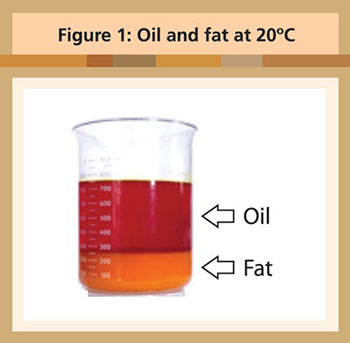
TYPES OF OILS AND FATS: THE TRAIN ANALOGY
The properties of the oils and fats are largely governed by the types of fatty acids present.
These fatty acids are further grouped together based on the number of vacant spaces within each acid.
To illustrate, think of a fatty acid as a train with a range of carriages. In each carriage, there are two vacant seats. If the seats in all the carriages are taken, the train is said to be saturated. If one seat each in the adjoining carriage is vacant, it is said to be monounsaturated. Likewise, two or more seats in the adjoining carriages are vacant, it is termed as polyunsaturated.
Polyunsaturated oils are very unstable. They have poor shelf life, which means the oil that is produced cannot be kept for long before turning bad (rancid). Such oil cannot be used for frying or for making solid products such as cakes, biscuits or pastries unless they are hydrogenated. Going back to the train analogy, hydrogenation process is like “forcing passengers to occupy the vacant seats” to stabilise it. In other words, it is an “artificial way to saturate” the oil. The hydrogenation process also creates another type of acid called trans fatty acid, which is a twisted form of the natural oleic acid. The analogy of the types of fatty acids are as sketched in Figure 2.
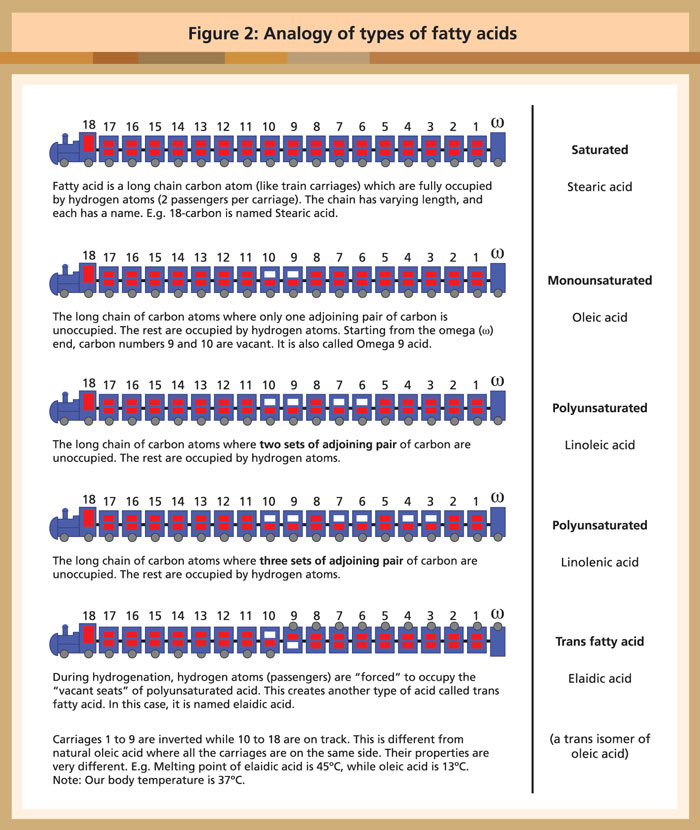
IS PALM OIL SATURATED OR UNSATURATED?
This is best answered by referring to Malaysian Standard, MS814:2007. The fatty acid composition for palm oil is as quoted in Table 1 (Adapted from Malaysian Standard, MS814:2007). The overall composition is:
| Palm oil | Mean |
| Saturated | 49.3% |
| Unsaturated | 50.6% |
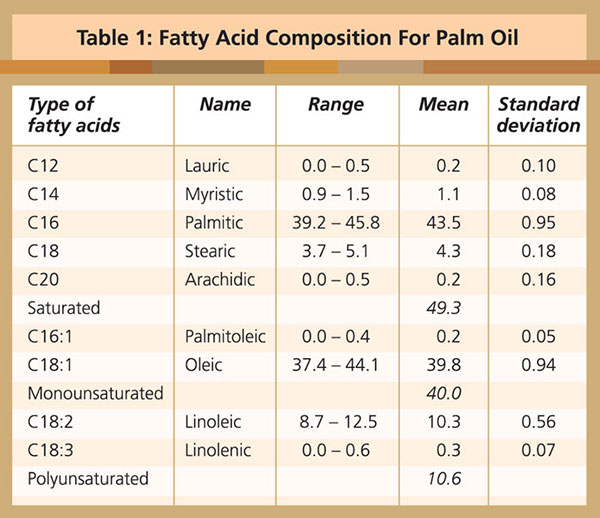
The points to note are:
• The arithmetic mean shows that palm oil is more than 50 per cent unsaturated. By a simple majority rule, palm oil is “unsaturated”. It is wrong to label palm oil as “saturated”.
• Apart from having natural liquid and solid fractions, there is another feature about palm oil, it naturally has nearly equal saturated and unsaturated portions.
This is a classic case of the proverbial “half empty or half full glass of water” expression. How one interprets it depends on one’s state of mind and intention. This is best defined by the Cambridge dictionary, which says:
“The glass is half empty” refers to an attitude of always thinking about the bad things in a situation rather than the good ones.
As evident from the above-mentioned, palm oil has more oil than fat and it is slightly more unsaturated than saturated. Based on these facts, palm oil should be labelled as an “unsaturated oil”. One can only surmise that whoever that labelled palm oil as a “saturated fat” choose to disregard or distort the facts because of ulterior motives.
SATURATED FAT AND HEART DISEASE
In the 1950s, heart disease was America’s number one killer and when President Eisenhower had a heart attack in 1955, there was a desperate need for answers (https://www.wsj.com/articles/the-questionable-link-between-saturated-fat-and-heart-disease-1399070926). It was Ancel Keys who hypothesised that dietary saturated fat causes cardiovascular heart disease and should be avoided (https://en.wikipedia.org/wiki/Ancel_Keys). The suggestion, as can be expected, was readily accepted.
In 1958, Keys’s subsequent observational “Seven Countries Study” demonstrated heart disease could be linked to poor nutrition. Keys, a physiologist, also ended up on the nutrition committee of AHA. In 1961, AHA issued the country’s first ever guidelines targeting saturated fat (https://www.wsj.com/articles/the-questionable-link-between-saturated-fat-and-heart-disease-1399070926). The guidelines had remained unchanged for many decades. On 15 June 2017, AHA’s stand was reaffirmed via its presidential address, which concluded that based on evidence, called for a reduction in saturated fat and replace it with polyunsaturated and monounsaturated fat (http://circ.ahajournals.org/content/early/2017/06/15/CIR.0000000000000510).
American Heart Association cherry picking data on saturated fats
Mr Gary Taubes, an award-winning science writer, author and a prominent investigative journalist took AHA to task in a post published by Cardio Brief, a source for new and important information about cardiovascular medicine.

AHA pretends to be science-based but is not. There is no strong scientific basis to support their guidelines but are opinions. Their recommendation that saturated fats be replaced with polyunsaturated fats, is based on cherry-picked and severely deficient data. With the devastating precision of a prosecuting attorney, Taubes lays out the case against the AHA paper. He doesn’t prove that saturated fat is innocent, but that’s not his goal. He does prove, beyond a reasonable doubt, that the evidence against saturated fat is inconsistent, weak, and unreliable. “If the data doesn’t exist, you must acquit,”I suppose he might say (http://www.cardiobrief.org/2017/06/21/my-beef-with-the-ahas-saturated-fat-recommendations/)
Taubes, was also quoted in Olive Health News, said “The AHA ignores results from some of the biggest studies ever conducted, including the Minnesota Coronary Survey, Sydney Heart Study and the Women’s Health Initiative” (https://www.oliveoiltimes.com/olive-oil-health-news/experts-dispute-aha-warning-saturated- fats-coconut-oil/58005).
One such example is the Sydney Heart Study quoted below.
Sydney (Diet) Heart study
In this cohort, substituting dietary linoleic acid (a polyunsaturated acid) in place of saturated fats increased the rates of death from all causes, coronary heart disease, and cardiovascular disease. An updated meta-analysis of linoleic acid intervention trials showed no evidence of cardiovascular benefit. These findings could have important implications for worldwide dietary advice to substitute omega 6 linoleic acid, or polyunsaturated fats in general, for saturated fats (http://www.bmj.com/content/346/bmj.e8707). These results clearly contradict AHA’s guidelines and as Mr Taubes quite rightly said, the results were ignored.
Nutritional policy: Personal ambition, bad science, politics and bias
Wall Street Journal also ran an article by Nina Teicholz, another investigative journalist and author of the International (and New York Times) bestseller, The Big Fat Surprise. She too questioned the saturated fat link. The nutritional policy, she writes, had been derailed over the past half-century by a mixture of personal ambition, bad science, politics and bias.
She added that there is no solid evidence to back up the idea that saturated fats cause disease. Critics have pointed out that Dr Keys violated several basic scientific norms in his study. For one, he did not choose countries randomly but instead selected only those likely to prove his beliefs, including Yugoslavia, Finland and Italy (https://www.wsj.com/articles/the-questionable-link-between-saturated-fat-and-heart-disease-1399070926). Keys’s original studies covered twenty-two countries out of which only seven countries were chosen.
Saturated fat and heart disease: A questionable link
In the last four years, two meta-analysis studies on saturated fats were published in reputable journals are mentioned below. Also included is a diet intervention study from Norway. Meta-analysis is a method for systematically combining pertinent qualitative and quantitative study data from several selected studies to develop a single conclusion that has greater statistical power (https://en.wikipedia.org/wiki/Meta-analysis).
In June 2015, American Oil Chemists Society (AOCS) reported a promising sign that the US Dietary Guidelines Advisory Committee is withdrawing its warning on cholesterol. Perhaps saturated fats will follow suit. These main points were extracted from an article in AOCS’s publication.
AOCS: Big fat controversy – Changing opinions about saturated fats
Nutritionists have long vilified saturated fat for its propensity to raise LDL (“bad”) cholesterol levels in the blood. Although initial epidemiological studies associated saturated fat intake with heart disease risk, subsequent studies have failed to confirm the link. Saturated fat raises HDL (“good”) cholesterol levels, perhaps ameliorating its effects on LDL cholesterol. An unintended consequence of a low-fat diet may be increased carbohydrate intake, which could actually raise heart disease risk compared to a higher-fat diet (https://www.aocs.org/stay-informed/read-inform/featured-articles/big-fat-controversy-changing-opinions-about-saturated-fats-june-2015).
Not all saturated fats are the same
A closer look at only the saturated fatty acids components of both animals and vegetable oils may help us understand the situation better (Table 2).
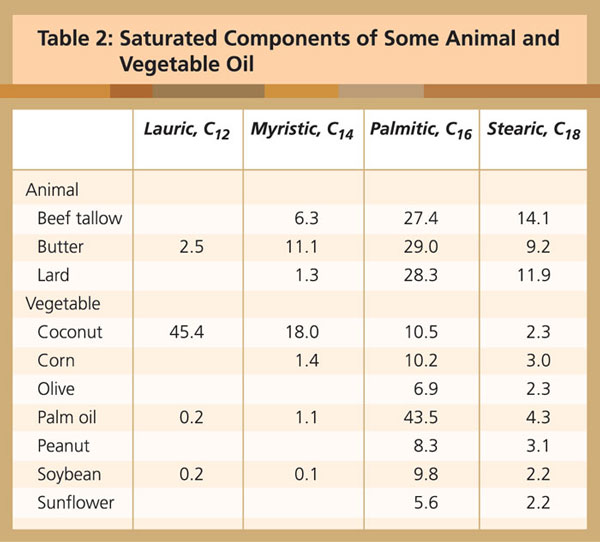
In palm oil, the predominant saturated acid is palmitic acid, and, to a lesser extent, stearic acid. The Cambridge team concluded:
Palm oil, the fall guy
The saturated fat mentioned so far referred mainly to red meat and dairy products. AHA’s recommendation is to switch to polyunsaturated vegetable oils, namely corn, soybean and canola. These oils require hydrogenation to mimic saturated oil. When health problems related to trans fats arose, labelling tropical oils as “saturated fat” fits the bill as no distinction is made between artificial or natural saturated fat. This made palm oil the main fall guy.
THE REAL HEALTH CULPRIT IS TRANS FATS
Dr Mary Enig, an internationally renowned nutritionist and lipids biochemist, is known for her unconventional positions on the role saturated fats play in diet and health. Her views appeared in “The big fat controversy” (https://experiencelife.com/article/big-fat-controversy).
The real health culprit is not saturated fats but rather trans fats, which were introduced into the food supply in great quantity by the soy industry in the 1950s. This is when partially hydrogenated fats were developed to imitate naturally saturated fats and to expedite the production of processed foods.
To create the solid substance, manufacturers typically take vegetable fats and bombard them with hydrogen, turning them into the solids used in commercial baked goods or to make shortening from vegetable oil. “They have a different shaping than the normal kind of fatty acids that are in the food supply or in the tissues of the body,” Enig says. “Trans fats also have a higher melting point, all of which can make them very harmful to the system.”
The food industry has so cleverly marketed these trans fats, insists Enig, and so regularly bad-mouthed saturated fats, that in the last 30 years their dogma has been accepted as gospel by the medical establishment – and, by extension, the general public, which is why low-fat, processed foods are so prevalent and popular these days.
Trans fats are deadly
Consumption of industrial trans fats was associated with a 34 per cent increase in death for any reason (https://fhs.mcmaster.ca/qa/network/fats.html; http://www.bmj.com/content/351/bmj.h3978). Time magazine carried an article that Denmark’s trans-fat ban in 2004 worked based on an article published in the American Journal of Preventive Medicine on 9 September 2015. Between 2003 and 2012, deaths caused by cardiovascular disease slid from 359.9 to 210.9 per 100 000 people, a 9-point drop. Between 2004 and 2006, cardiovascular disease mortality rates dropped by 4 per cent – the equivalent to 750 fewer deaths per year in that period (http://time.com/4025570/denmark-trans-fat-ban/).
On 16 June 2015, the US Food and Drug Administration gave the food industry three years to eliminate artery-clogging artificial trans fats from the food supply, a long-awaited step that capped years of effort by consumer groups and is expected to save thousands of lives a year (https://www.nytimes.com/2015/06/17/health/fda-gives-food-industry-three-years-eliminate-trans-fats.html). On 14 August 2015, in the British Medical Journal, experts from Oxford and Liverpool Universities suggested that banning trans fats from processed foods could save around 7 200 deaths from heart disease in England over the next five years (http://www.bmj.com/content/351/bmj.h4583). In Malaysia, popular commercial pastry shortening samples were found to contain up to 34.4 per cent trans fats (http://palmoilis.mpob.gov.my/publications/TOT/TT540.pdf).
HARVARD SCIENTISTS PAID TO SHIFT BLAME FROM SUGAR TO SATURATED FAT
The Journal of the American Medical Association (JAMA) dropped the bombshell by reporting that the sugar industry paid scientists to shift blame on saturated fat. This was picked up by various newspapers and excerpts from The New York Times on 12 September 2016 (https://www.nytimes.com/2016/09/13/well/eat/how-the-sugar-industry-shifted-blame-to-fat.html).
The sugar industry paid scientists in the 1960s to play down the link between sugar and heart disease and promote saturated fat as the culprit instead, newly released historical documents show.
The internal sugar industry documents, recently discovered by a researcher at the University of California, San Francisco, and published in JAMA Internal Medicine, suggest that five decades of research into the role of nutrition and heart disease, including many of today’s dietary recommendations, may have been largely shaped by the sugar industry.
“They were able to derail the discussion about sugar for decades,” said Stanton Glantz, a professor of medicine at U.C.S.F. and an author of the JAMA Internal Medicine paper.
The documents show that a trade group called the Sugar Research Foundation, known today as the Sugar Association, paid three Harvard scientists the equivalent of about $50,000 in today’s dollars to publish a 1967 review of research on sugar, fat and heart disease. The studies used in the review were handpicked by the sugar group, and the article, which was published in the prestigious New England Journal of Medicine, minimized the link between sugar and heart health and cast aspersions on the role of saturated fat.
Even though the influence-peddling revealed in the documents dates back nearly 50 years, more recent reports show that the food industry has continued to influence nutrition science.
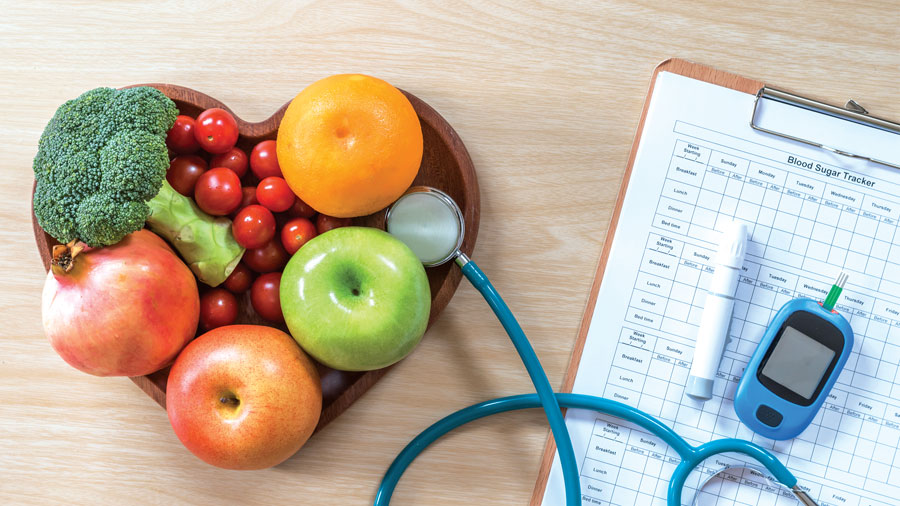
CONCLUSION
Palm oil is a good oil. It is tainted by unscrupulous competitors in a non-level oils and fats playing field. Currently, there is an outstanding issue of 3 MCPD, a suspected carcinogen to be managed. Palm oil is non-GMO and is mechanically extracted. This is a very strong plus point which will give the oil an edge over its competitors – oilseeds that are mainly solvent extracted. Palm oil extraction efficiency is about 92 per cent compared to around 98 per cent with solvent. Preventing remnant oil recovered from being added back into the system to increase oil extraction is the first step in preventing 3 MCPD. As consumers ourselves, we must adhere to the universal rule: “Food safety must precede profits”, failing which, we are no better than the manufacturers of trans fats!
Ng Say Bock & Vincent Ng
Source: The Planter, Kuala Lumpur, 94 (1103): 79-88 (2018)
This article is reproduced with permission of ‘The Planter’ and the Incorporated Society of Planters.
By gofb-adm on Monday, June 24th, 2019 in Issue 2 - 2019, Sustainability No Comments
The emergence and presence of numerous sustainability benchmarks and standards for palm oil intensify the need for the sector to transform itself so that sustainable practices become institutionalised over time.
Read more »By gofb-adm on Monday, June 24th, 2019 in Issue 2 - 2019, Comment No Comments
lections to the European Parliament took place in May, changing the composition of the EU’s assembly, at least to a certain extent. While the approach towards palm oil by the European Parliament and its Members (MEPs) after the elections remains largely uncertain, it is clear that palm oil had many outspoken critics in the previous legislature.
Read more »By gofb-adm on Monday, June 24th, 2019 in Issue 2 - 2019, Markets No Comments
The global economic uncertainties of 2017 continued into 2018. The year was punctuated by escalating trade disputes, especially between the US and China, and episodes of financial stress and volatility amidst an undercurrent of geo-political tensions.
Read more »By gofb-adm on Monday, June 24th, 2019 in Issue 2 - 2019, Markets No Comments
The US is one of the world’s major consumers of oils and fats. Its total consumption in 2017 amounted to 22.5 million tonnes, comprising mainly soybean oil, canola oil and corn oil. The US has a relatively low palm oil per capita consumption, owing to the dominance of domestic soybean oil and corn oil in the edible oils market. Palm oil consumption amounted to about 1.4 million tonnes in 2018.
Read more »